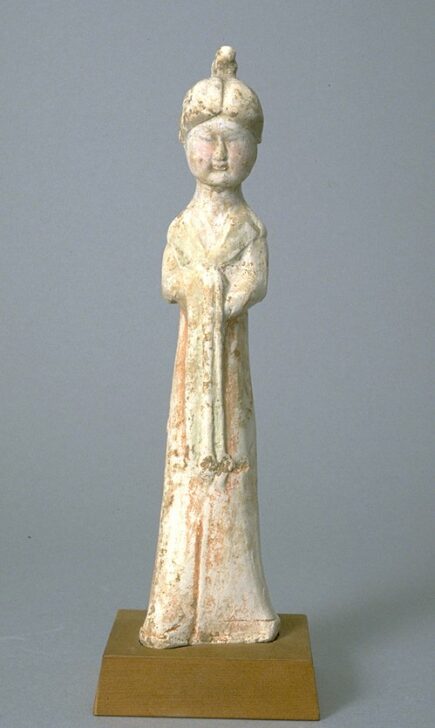Court Dancer
Chinese

Description
Court Lady
China, Tang dynasty (618–907)
Earthenware with slip and pigment
Gift of Mr. William T. and Maria H.
Carter in memory of their son,
Charles A. Dickerman, 1984/1.298
(Chinese Gallery Rotation, Summer 2025)
Subject Matter:
An earthenware mingqi (明器), "bright object," figure of a long-sleeved court dancer of the Tang dynasty (618-906).
This figure, while standing demurely, is a court dancer as indicated by her long sleeves that would be tossed up in the air during the dance to create beautiful floating and whirling scenes. Most court dancers and musicians during the Tang dynasty were women; having them in ones tomb was thought to provide high-class entertainment for the deceased, and shows the wealth and high-status of the occupant.
Since the Qin dynasty (221-206 BCE), ceramic figures have been used to replace human sacrifice in burial practices as mingqi (明器), "bright objects," or grave goods, as a way to provide for the deceased. Mingqi could include houses, towers, gates, granaries, livestock pens, chicken coops, wells, cooking stoves, storage vessels, dishes, incense burners, and lamps. Figures could include horses, dogs, anthropomorphic animals and people such as officials, guardians, servants and entertainers. By the Han dynasty, they also included representations of common people engaged in the activities that consumed their daily lives such a cooking. The tombs in the southern provinces of Sichuan and Shaanxi have revealed a vast array of figures in playful and humorous poses. As grave goods, these mingqi included everything one would need to ensure a comfortable transition into the afterlife. A tomb could contain anywhere from a few, to several hundred ceramic mingqi items.
Physical Description:
An earthenware female figure, thin and tall, standing with arms clasped in front of the body, wearing long robes with a wide collar, tied at the waist, with the fabric of her long sleeves folded over her hands. She has a round face with petite details, her hair is parted down the middle and tied up in a high chignon. The sculpture is covered in polychrome mineral pigments.
Usage Rights:
If you are interested in using an image for a publication, please visit https://umma.umich.edu/request-image/ for more information and to fill out the online Image Rights and Reproductions Request Form.